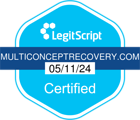Because recovery involves more than completing a rehabilitation program, relapse addiction aftercare requires a unique approach on a personal level. The American Society of Addiction Medicine (ASAM) describes addiction as a chronic disease — one with biological, behavioral, emotional, social, and physical factors. By nature, those suffering from substance abuse disorder cannot control their cravings. That’s why it’s so important to find a program that works for you.
A Unique Approach
Effective treatment centers offer choices to their clients. It’s also important to find an evidence-based program based on clinical trials and scientific research. This promotes long-term recovery since it’s based on already proven methods. Because no two clients are alike, relapse prevention must address the unique needs of the whole individual.
The goal of the recovery center should be to engage clients on every level — from spiritual to intellectual and from emotional to physical standpoints. Not all treatment techniques work for each individual. At the end of the day, the disease of addiction affects people from all walks of life, which is why multiple paths have to be available to those ready to make a change.
Relapse addiction aftercare is a continuous form of treatment. It immediately follows the initial addiction treatment care — inpatient rehab or intensive outpatient treatment.
Aftercare Is Crucial to Long-Term Recovery
In the United States, relapse rates are very high, from 37% to 56%. Having an aftercare plan in place helps substance abuse clients stay sober and avoid drug use. One of the most crucial stages is the time following a formal treatment plan. During this time, there’s an opportunity to reinforce the techniques learned in rehabilitation. This includes coping strategies that give those in recovery the strength to carry on, such as:
- Group counseling involves listening to others share their experiences. When they are ready, patients can join in on the conversation about addiction. A group setting also helps participants build coping skills and forge supportive relationships.
- Outpatient treatment takes place in the comfort of home. As long as a nurturing environment exists, recovery can continue, with the addition of attending treatment a few times every week
- Individual therapy describes one-on-one meetings with a therapist. During these sessions, additional progress is made on skills learned during formal treatment programs.
- 12-step programs are programs such as Narcotics Anonymous (NA) and Alcoholics Anonymous (AA) that support members during recovery and beyond.
Medications and Relapse Addiction Aftercare
Sometimes, medications are used to help clients stop using drugs and alcohol. Here are the most common approaches, according to the National Institute on Drug Abuse (NIDA).
- Treating withdrawal is an important and effective way to prevent cravings and relapse. The withdrawal comes with physical and emotional impacts that make it difficult to sleep and function normally. Some people also experience depression and anxiety during this time. Certain treatment medications reduce the impact of withdrawal in order to support a full recovery.
- Continued treatment. Treatment medications and mobile applications may help the brain accept the absence of the drug. Over time, this treatment eliminates drug cravings and keeps the body calm. This lets patients focus on healing, counseling, and recovery.
- Preventing relapse. Stress often triggers a relapse. Scientists are developing therapies that help block these triggers to help patients stay clean.
By combining these and other techniques, after programs can help prevent a return to addiction cycles and prevent relapses. It’s essential to find a program with caring staff and flexible programs that put the needs of the individual first when it comes to developing a recovery strategy that sticks. Call or check out the Multi Concept Recovery provider for treatment in the Burbank area of Los Angeles, California.
